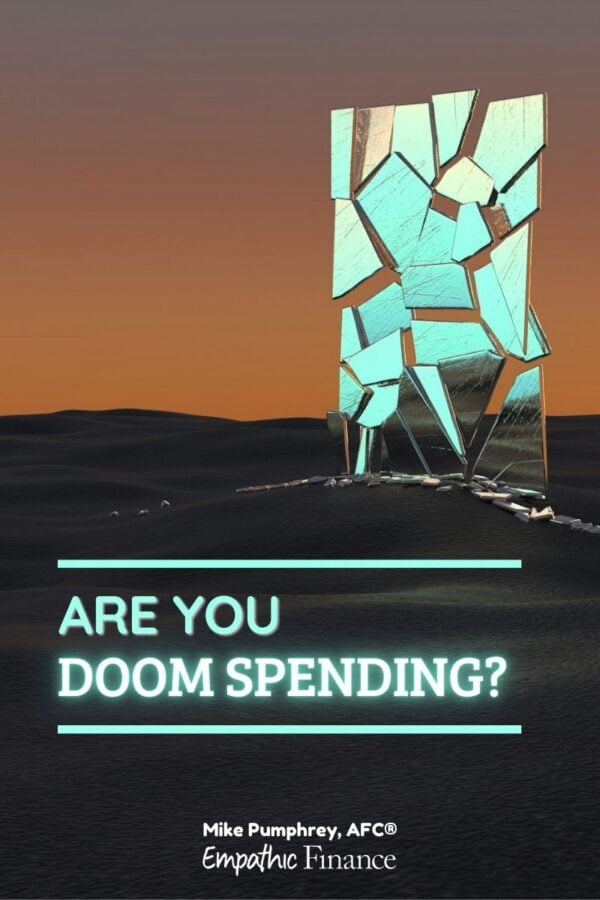A phrase, doom spending (or doomspending) gets to the heart of the hopelessness people face about their finances and their future.
I don’t know if life has ever been easy, but it probably doesn’t feel easy now.
While inflation is less of a big deal these days than it was a year or two ago, the prices of basically everything are more unaffordable than ever before in our lifetimes. With the exception of cheap garbage on Temu, everything is a little harder to buy.
In 1955, you could buy a new home for about $8,000, which in today’s money is about $94,000. Good luck buying anything for that price today.
But I don’t need to tell you anything you don’t already know. The question is, what do we do about it?
Well, some of us, it turns out, are doom spending.
Table of Contents
Doom spending
Doom spending is the act of spending money on unaffordable things as a way of coping with stress. Or, another way of looking at it, it is the financial behaviors that result from a feeling of hopelessness or dread.
Doom spending (or doomspending, as these things often become contracted over time) is sort of the financial analog to “doomscrolling”, the act of endlessly looking at bad news or events because of a belief that everything is falling apart.
I first heard of this particular phenomenon while watching this rather engaging YouTube video about how the American Dream is now unaffordable to most people.
From the narration:
“In a time when the average American can’t afford an unexpected $1,000 expense, luxury good companies selling $5,000 handbags or $10,000 watches are making record profits. This is because of a phenomenon known as doom spending.
If you have worked hard in school, landed a good job, worked for 10 years, and are no closer to owning a home of your own, it’s reasonable to see some kind of reward for all of your hard work. If you can’t afford a sensible purchase to treat yourself, you could at least buy something that makes it look like you have some kind of financial stability in your life. It’s not logical, but these companies don’t make billions of dollars selling $2,000 shoes by appealing to logic.
Doom spending is all a part of a bigger trend if people just giving up.”
Yikes.
The heavy hitters weighed in too. Here’s Bloomberg:
“‘The economy sucks, there’s global warming, there’s constant political and social unrest globally,’ one 24-year-old told Bloomberg News, justifying her purchase of the occasional ‘little luxury,’ like the vintage Chanel bag she picked up for $2,500…’It’s just easier to spend money on things that will bring you immediate fulfillment,’ she continued, especially when saving doesn’t seem to bring life’s major expenditures—a home, children—any closer.”
It’s bad out there
I’m not here to be Pollyanna about things. It’s objectively true that major adult milestones in our society have become less affordable. From college degrees, to cars, to homes, to children, there’s not really a single metric there that’s gotten more affordable.
If you’ve been in the trenches for years, trying to find your ways out of a cycle of living paycheck to paycheck, you might believe that there’s no way out, that this is how your life is going to be, that progress is impossible.
So, you might think you might as well buy the expensive car or clothes, and just throw it on your credit card. It doesn’t matter; you’re screwed anyway.
So don’t make it worse
But while it might feel good in the moment to say “the hell with it” so you can get some stuff, you will in the process make everything worse for yourself.
Sure, you’ll have a nice pair of shoes or a watch. But now you’ll have even more credit card debt, which will make it even harder for you to dig out of the hole you find yourself in.
Large purchases take years to pay off. That pair of shoes you bought probably won’t last as long as the payments you’ll have. How exactly does this help you?
Also, make no mistake that companies are very much going to encourage doom spending. From the Bloomberg article above, there’s not too much daylight between the older slogan “Because you’re worth it,” to a newer slogan of “Because nothing’s worth it.”
Pushing back on the video
As an aside, I’m not convinced that these luxury retailers of watches and shoes are making bank because of doom scrolling. Given the massive income inequality in our society, there are plenty of people in the top percentiles of our economy for whom $10,000 watches are no big deal. We do have a two-tier economy, where luxury is actually quite affordable to many.
But if you’re not not in that tier, than these things are as unaffordable as a first-time mortgage is.
Is it really hopeless? No.
As a financial coach, I routinely hear from clients that they feel like they spend “too much” on certain categories: restaurants, clothes, Amazon. But when I ask how much they’re spending, I typically receive a blank look. They don’t know.
People who feel like they have no wiggle room have often never checked this feeling out by tracking their spending. They seem content to just “feel” bad.
Just spending money and wondering where it went is a recipe for never getting anywhere. You have to be intentional with money before you can succeed with it. This means knowing what you spend, and making a plan for your money, every month, going forward. You will find extra money when you do this.
So instead of using the feeling of hopelessness to give yourself permission to buy whatever you want, how about instead working the plan that I’ve been helping people with for years. Be intentional with your money, make plans, and stick to them over time. Try a money reset. I guarantee you won’t be stuck anymore.
On the other hand, if you start doom spending, you won’t be any happier, and you will be in a worse place. Just because things are hard doesn’t mean they’re hopeless.



